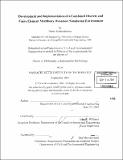| dc.contributor.advisor | John R. Williams. | en_US |
| dc.contributor.author | Komodromos, Petros I. (Petros Ioannis) | en_US |
| dc.contributor.other | Massachusetts Institute of Technology. Dept. of Civil and Environmental Engineering. | en_US |
| dc.date.accessioned | 2006-02-02T18:48:19Z | |
| dc.date.available | 2006-02-02T18:48:19Z | |
| dc.date.copyright | 2001 | en_US |
| dc.date.issued | 2001 | en_US |
| dc.identifier.uri | http://hdl.handle.net/1721.1/31102 | |
| dc.description | Thesis (Ph. D.)--Massachusetts Institute of Technology, Dept. of Civil and Environmental Engineering, 2001. | en_US |
| dc.description | Includes bibliographical references (p. [195]-198) and index. | en_US |
| dc.description.abstract | Some engineering applications and physical phenomena involve multiple bodies that undergo large displacements involving collisions between the bodies. Considering the difficulties and cost associated when conducting physical experiments of such systems, there is a demand for numerical simulation capabilities. The discrete element methods (DEM) are numerical techniques that have been specifically developed to facilitate simulations of distinct bodies that interact with each other through contact forces. In DEM the simulated bodies are typically assumed to be infinitely rigid. However, there are multibody systems for which it is useful to take into account the deformability of the simulated bodies. The objective of this research is to incorporate deformability in DEM, enabling the evaluation of the stress and strain distributions within simulated bodies during simulation. In order to achieve this goal, an Updated Lagrangian (UL) Finite Element (FE) formulation and an explicit time integration scheme have been employed together with some simplifiying assumptions to linearize this highly nonlinear contact problem and obtain solutions with realistic computational cost. An object-oriented extendable computational tool has been built specifically to allow us to simulate multiple distinct bodies that interact through contact forces allowing selected bodies to be deformable. Database technology has also been utilized in order to efficiently handle the huge amounts of computed results. | en_US |
| dc.description.statementofresponsibility | by Petros Komodromos. | en_US |
| dc.format.extent | 200, [1] p. | en_US |
| dc.format.extent | 11144320 bytes | |
| dc.format.extent | 11170425 bytes | |
| dc.format.mimetype | application/pdf | |
| dc.format.mimetype | application/pdf | |
| dc.language.iso | eng | en_US |
| dc.publisher | Massachusetts Institute of Technology | en_US |
| dc.rights | M.I.T. theses are protected by copyright. They may be viewed from this source for any purpose, but reproduction or distribution in any format is prohibited without written permission. See provided URL for inquiries about permission. | en_US |
| dc.rights.uri | http://dspace.mit.edu/handle/1721.1/7582 | |
| dc.subject | Civil and Environmental Engineering. | en_US |
| dc.title | Development and implementation of a combined discrete and finite element multibody dynamics simulation environment | en_US |
| dc.type | Thesis | en_US |
| dc.description.degree | Ph.D. | en_US |
| dc.contributor.department | Massachusetts Institute of Technology. Department of Civil and Environmental Engineering | |
| dc.identifier.oclc | 50151200 | en_US |
